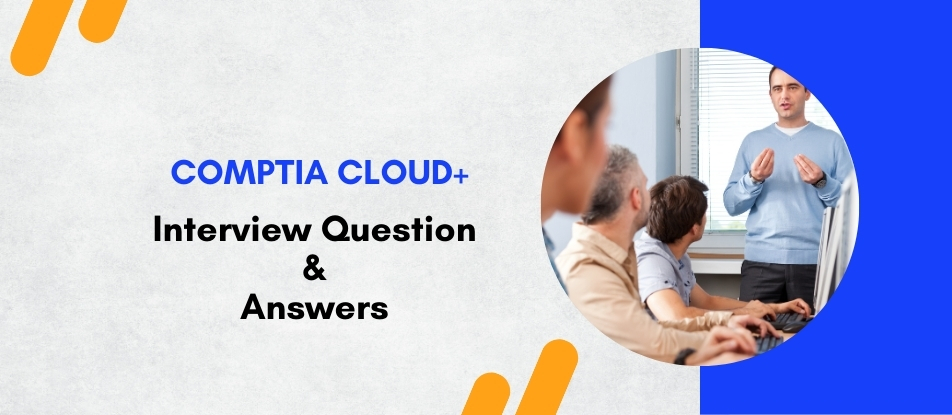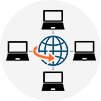
The CompTIA Cloud+ training course provides comprehensive coverage of cloud concepts, models, and security, ensuring participants understand cloud infrastructure services in a multi-vendor environment. It equips IT professionals with essential skills to deploy, optimize, and troubleshoot cloud resources, emphasizing both operational and maintenance aspects. The course is ideal for those looking to validate their cloud knowledge and advance their career in cloud computing.
CompTIA Cloud+ Interview Questions - For Intermediate
1. What is cloud computing?
Cloud computing refers to the delivery of computing services over the internet, including storage, servers, databases, networking, software, and more.
2. What are the key components of a cloud architecture?
Key components include the front end, back end, network, and cloud service delivery models (SaaS, PaaS, IaaS).
3. Explain the difference between public, private, and hybrid clouds.
Public clouds are owned and operated by third-party providers, private clouds are dedicated to a single organization, and hybrid clouds combine both public and private cloud environments.
4. What is virtualization, and how does it relate to cloud computing?
Virtualization is the process of creating a virtual (rather than actual) version of something, such as a server, operating system, storage device, or network resource. Cloud computing often relies on virtualization to maximize resource utilization.
5. What are the benefits of cloud computing?
Benefits include cost savings, scalability, flexibility, accessibility, and increased efficiency.
6. What are some common cloud deployment models?
Common deployment models include public cloud, private cloud, hybrid cloud, and community cloud.
7. What security considerations are important in cloud computing?
Security considerations include data privacy, compliance, identity and access management, encryption, and secure network configurations.
8. Explain the concept of elasticity in cloud computing.
Elasticity refers to the ability to scale resources up or down based on demand, allowing organizations to efficiently manage fluctuating workloads.
9. What is the difference between SaaS, PaaS, and IaaS?
SaaS (Software as a Service) provides software applications over the internet, PaaS (Platform as a Service) provides a platform for developing and deploying applications, and IaaS (Infrastructure as a Service) provides virtualized computing resources over the internet.
10. What is a hypervisor?
A hypervisor is a software or firmware that creates and runs virtual machines (VMs), allowing multiple operating systems to share a single hardware host.
11. Explain the concept of cloud bursting.
Cloud bursting is the use of public cloud resources to handle spikes in demand when on-premises resources are insufficient.
12. What are some common challenges in cloud migration?
Common challenges include data migration, compatibility issues, security concerns, and integration complexities.
13. How do you ensure data integrity and availability in the cloud?
Data integrity and availability can be ensured through redundancy, backups, disaster recovery planning, and robust security measures.
14. What is network latency, and how does it affect cloud performance?
Network latency refers to the delay in data transmission over a network. High latency can negatively impact cloud performance by slowing down data transfer and response times.
15. Explain the concept of a cloud service-level agreement (SLA).
A cloud SLA is a contract between a cloud service provider and a customer that defines the terms of service, including performance, availability, security, and support.
16. What are some best practices for optimizing cloud costs?
Best practices include rightsizing resources, using reserved instances, leveraging automation, monitoring usage, and implementing cost management tools.
17. What is cloud orchestration, and why is it important?
Cloud orchestration is the automated arrangement, coordination, and management of cloud resources and services. It is important for efficient deployment, scaling, and management of cloud-based applications and infrastructure.
18. How do you handle data sovereignty and compliance requirements in the cloud?
Data sovereignty and compliance requirements can be addressed through data encryption, access controls, geographic restrictions, and adherence to relevant regulations such as GDPR or HIPAA.
19. What is a cloud management platform (CMP), and what are its key features?
A CMP is a software tool or suite of tools used to manage and monitor cloud resources and services. Key features include provisioning, monitoring, automation, cost management, and security.
20. How do you stay updated on the latest trends and developments in cloud computing?
Staying updated involve participating in industry events, attending webinars, reading industry publications, joining professional organizations, and pursuing relevant certifications or training courses.
CompTIA Cloud+ Interview Questions - For Advanced
1. Question: What are the key considerations when designing a multi-cloud strategy?
When designing a multi-cloud strategy, key considerations include interoperability, data portability, and vendor lock-in avoidance. It is essential to ensure that applications and services can operate across different cloud environments without significant rework. Data portability involves the ability to move data seamlessly between clouds, requiring compatible data formats and transfer protocols. Avoiding vendor lock-in ensures flexibility, allowing the organization to switch providers if needed without excessive costs or disruptions. Additionally, security and compliance must be addressed across all cloud environments, ensuring consistent policies and controls. Performance monitoring and cost management are also critical, as they help optimize resource utilization and budget allocation.
2. Question: How can cloud infrastructure be optimized for cost efficiency?
Cloud infrastructure can be optimized for cost efficiency by employing several strategies. First, using a right-sizing approach ensures that resources match workload requirements, avoiding over-provisioning. Second, implementing auto-scaling can dynamically adjust resource allocation based on real-time demand. Third, leveraging reserved instances and spot instances can provide cost savings for predictable workloads and flexible, non-critical tasks, respectively. Additionally, regular monitoring and analysis of resource utilization help identify and eliminate underused or idle resources. Utilizing cost management tools provided by cloud service providers can also offer insights and recommendations for cost optimization. Finally, implementing effective governance policies ensures that resources are provisioned and de-provisioned in line with organizational policies.
3. Question: Explain the importance of automation in cloud management and some common tools used for this purpose.
Automation in cloud management is crucial for improving efficiency, reducing human error, and ensuring consistency in repetitive tasks. It allows for faster provisioning and scaling of resources, improving overall responsiveness and agility. Automation can also enhance security by applying consistent configurations and policies across the environment. Common tools used for automation include Infrastructure as Code (IaC) tools like Terraform and AWS CloudFormation, which enable the management of cloud resources through code. Configuration management tools such as Ansible, Puppet, and Chef automate the deployment and management of applications and infrastructure. Continuous Integration/Continuous Deployment (CI/CD) tools like Jenkins and GitLab CI automate the software development lifecycle, facilitating rapid and reliable code deployment.
4. Question: What are the best practices for securing a hybrid cloud environment?
Securing a hybrid cloud environment involves several best practices. First, implementing a comprehensive identity and access management (IAM) system ensures that only authorized users have access to resources. Multi-factor authentication (MFA) adds an extra layer of security. Second, data encryption should be used for both data at rest and in transit to protect sensitive information. Third, regular security assessments and vulnerability scanning help identify and remediate potential weaknesses. Establishing consistent security policies and controls across both on-premises and cloud environments is essential for maintaining a unified security posture. Network security measures such as firewalls, VPNs, and intrusion detection systems (IDS) should be employed to protect data flow between environments. Lastly, continuous monitoring and logging provide visibility into the environment, enabling quick detection and response to security incidents.
5. Question: How does containerization enhance application deployment and management in the cloud?
Containerization enhances application deployment and management in the cloud by providing a lightweight and consistent environment for applications to run. Containers package applications along with their dependencies, ensuring that they run consistently across different environments. This eliminates the "it works on my machine" problem and simplifies the deployment process. Containers also improve resource utilization by allowing multiple containers to run on a single host without the overhead of virtual machines. Tools like Docker and Kubernetes facilitate the orchestration, scaling, and management of containerized applications. Kubernetes, in particular, offers advanced features like automated rollouts and rollbacks, self-healing, and service discovery, making it easier to manage large-scale container deployments.
6. Question: Describe the concept of Infrastructure as Code (IaC) and its benefits.
Infrastructure as Code (IaC) is a practice where infrastructure provisioning and management are performed using code rather than manual processes. IaC allows for the automation of infrastructure setup, making it repeatable, consistent, and scalable. Benefits of IaC include improved efficiency and speed of deployment, as infrastructure can be provisioned quickly through code execution. It also enhances consistency and reduces human error, as the code ensures standardized configurations. Version control systems can track changes to infrastructure code, providing an audit trail and enabling rollback to previous states if needed. IaC facilitates collaboration among teams, as infrastructure configurations can be shared and reviewed like application code. Tools like Terraform, AWS CloudFormation, and Azure Resource Manager are commonly used for implementing IaC.
7. Question: What are the challenges of managing cloud-native applications, and how can they be addressed?
Managing cloud-native applications presents several challenges, including complexity, scalability, and monitoring. The distributed nature of cloud-native applications, often composed of microservices, can complicate management and troubleshooting. To address these challenges, adopting DevOps practices and automation tools can streamline deployment and operations. Implementing comprehensive monitoring and logging solutions like Prometheus and ELK Stack provides visibility into application performance and health. Scalability issues can be managed using container orchestration tools like Kubernetes, which automate the scaling and management of containerized applications. Security is another challenge, requiring robust IAM policies, network segmentation, and regular security assessments to protect the application and data.
8. Question: How does a disaster recovery (DR) plan differ in a cloud environment compared to traditional on-premises environments?
A disaster recovery (DR) plan in a cloud environment differs from traditional on-premises environments in several ways. Cloud DR plans leverage the inherent capabilities of cloud providers, such as geographic redundancy, automated backups, and rapid resource provisioning. This enables quicker recovery times and more flexible recovery options. Cloud DR plans often use multi-region or multi-cloud strategies to ensure high availability and resilience. Additionally, the pay-as-you-go model of cloud services allows for cost-effective DR solutions, as resources can be provisioned and de-provisioned as needed. Traditional on-premises DR plans require significant investment in duplicate hardware and infrastructure, while cloud DR can dynamically utilize existing cloud resources, reducing upfront costs and complexity.
9. Question: What are the considerations for implementing a cloud-based data lake, and how does it differ from traditional data storage solutions?
Implementing a cloud-based data lake involves several considerations, including scalability, data ingestion, and security. A data lake must be able to scale to accommodate large volumes of diverse data types, from structured to unstructured data. Efficient data ingestion pipelines are essential to handle the continuous flow of data from various sources. Security measures, such as encryption, IAM policies, and compliance with regulations, are crucial to protect sensitive data. Unlike traditional data storage solutions, a data lake allows for the storage of raw data in its native format, enabling advanced analytics and machine learning. Cloud-based data lakes offer flexible storage and compute resources, allowing for on-demand processing and analysis. Services like AWS S3, Azure Data Lake, and Google Cloud Storage provide the foundational infrastructure for building cloud-based data lakes.
10. Question: Explain the role of service mesh in microservices architecture and its benefits.
A service mesh is a dedicated infrastructure layer that manages communication between microservices in a microservices architecture. It provides features such as traffic management, service discovery, load balancing, security, and observability. The service mesh abstracts the complexity of service-to-service communication, allowing developers to focus on business logic rather than inter-service communication concerns. Benefits of using a service mesh include enhanced security through mutual TLS encryption, improved reliability with automated retries and circuit breaking, and increased observability with detailed metrics, logs, and traces. Popular service mesh implementations like Istio and Linkerd offer a comprehensive set of tools to manage and secure microservices communication, ensuring robust and scalable application performance.
Course Schedule
| Apr, 2025 | Weekdays | Mon-Fri | Enquire Now |
| Weekend | Sat-Sun | Enquire Now | |
| May, 2025 | Weekdays | Mon-Fri | Enquire Now |
| Weekend | Sat-Sun | Enquire Now |
Related Courses
Related Articles
Related Interview
Related FAQ's
- Instructor-led Live Online Interactive Training
- Project Based Customized Learning
- Fast Track Training Program
- Self-paced learning
- In one-on-one training, you have the flexibility to choose the days, timings, and duration according to your preferences.
- We create a personalized training calendar based on your chosen schedule.
- Complete Live Online Interactive Training of the Course
- After Training Recorded Videos
- Session-wise Learning Material and notes for lifetime
- Practical & Assignments exercises
- Global Course Completion Certificate
- 24x7 after Training Support












 Join our Live Instructor-Led online classes delivered by industry experts
Join our Live Instructor-Led online classes delivered by industry experts